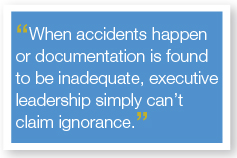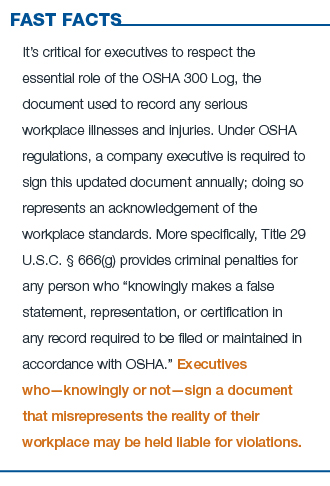New reporting requirements means increased risk and executive liability exposure
New OSHA recordkeeping and reporting compliance regulations that went into effect on January 1, 2015, revised the list of industries once exempt from certain levels of reporting, and after years of taking a more consultative stance, OSHA is returning to stricter enforcement across the board. For some companies, this means increased risk and liability exposure for executives.
In particular, executives must recognize that if they are willfully violating safety and health standards, OSHA can refer a case involving an employee injury to law enforcement for criminal prosecution. This includes incidents associated with a perception of gross negligence by executive staff. Anyone with pre-existing knowledge of a violation, or who shows blatant disregard for an employee’s safety can be cited, fined and potentially jailed – especially if the company hasn’t put in place the proper controls and coverage. OSHA willful violations can carry $70,000 fines, while violations that cause a loss of life can be upwards of $250,000 for individuals and $500,000 for companies. It is important to note that an executive liability policy won’t pay for fines or penalties levied by OSHA. 
“There is a strong connection between risk consulting and professional liability,” says Matt Gilmore, Senior Vice President of HUB Risk Services. “We work with clients to help them create a safer work environment, while reducing exposure for executive leadership.”
Best Practices and Policies for Safety and Compliance
Jessie Davis, VP, Executive Liability Practice Leader for HUB International, stresses the value of documentation on all levels: “What do you have on paper? What are you putting into practice? What are you communicating to your employees? When it’s all on paper, you have a happy company,” she says.
Staying in compliance and mitigating risk requires a variety of practices and policies that must be created, communicated and carried out:
- Upper level management commitment. Davis says many companies have an employee handbook that includes a signed commitment to the health and safety of employees. But savvy executive leaders go above and beyond, posting that document in public areas to remind everyone —even visitors—of the company’s commitment.
- Put safety into practice at all levels. “Handbooks and manuals are living, breathing documents that should be updated as new safety issues and procedures are identified,” says Davis. Training all employees in safety—consistently throughout their employment history—reinforces practices and reduces risks.
 Include safety practices in the employee handbook. A clear, thorough description of all safety practices and procedures—as well as the disciplinary process—not only helps reinforce the company culture of safety and accountability, but also serves as documentation in case of an OSHA inspection.
Include safety practices in the employee handbook. A clear, thorough description of all safety practices and procedures—as well as the disciplinary process—not only helps reinforce the company culture of safety and accountability, but also serves as documentation in case of an OSHA inspection. - Stay current. This includes OSHA regulatory requirements and enforcement, state-specific regulations, industry-specific injury and accident trends, and common industry violations. “When accidents happen or documentation is found to be inadequate, executive leadership simply can’t claim ignorance ,” says Gilmore.
- Maintain visibility and accountability. Live up to the policies stated in employee and safety manuals and enforce regulations consistently. Communicate policy to every single employee to help foster a culture that promotes safety. “Most companies strive for this, but few achieve it,” says Philip Casto, CSP, CHST, CFPS, CHMM, CRIS, Sr. Risk Consultant for HUB International. “It’s important to create a mechanism that supports employee ideas in order to make the workplace safer.”
- Perform audits. Once again, consistency is key. Assess and evaluate safety program on a regular basis and use performance data. Make changes as need, and communicate those changes quickly and clearly to all employees.
- Maintain an inside compliance manager, or hire a consultant. A compliance expert can review policies and procedures for adherence to state and federal laws. An expert can also drive changes to the current culture and level of employee engagement.
Finally, it’s critical for executives to respect the essential role of the OSHA 300 Log, the document used to record any serious workplace illnesses and injuries. Under OSHA regulations, a company executive is required to sign this updated document annually; doing so represents an acknowledgement of the workplace standards. More specifically, Title 29 U.S.C. § 666(g) provides criminal penalties for any person who “knowingly makes a false statement, representation, or certification in any record required to be filed or maintained in accordance with OSHA.” Executives who—knowingly or not—sign a document that misrepresents the reality of their workplace may be held liable for violations.
Take the Next Step Today
Risk exists at all companies, for all employees—from entry-level workers to top-level executives. The best way to mitigate risk is to have a plan, get educated, follow the plan consistently, maintain clear and consistent communication and retain proper insurance coverage. Contact your local HUB International risk services or executive liability consultant today to ensure your business practices are OSHA compliant and your executives are supported with the right coverage.